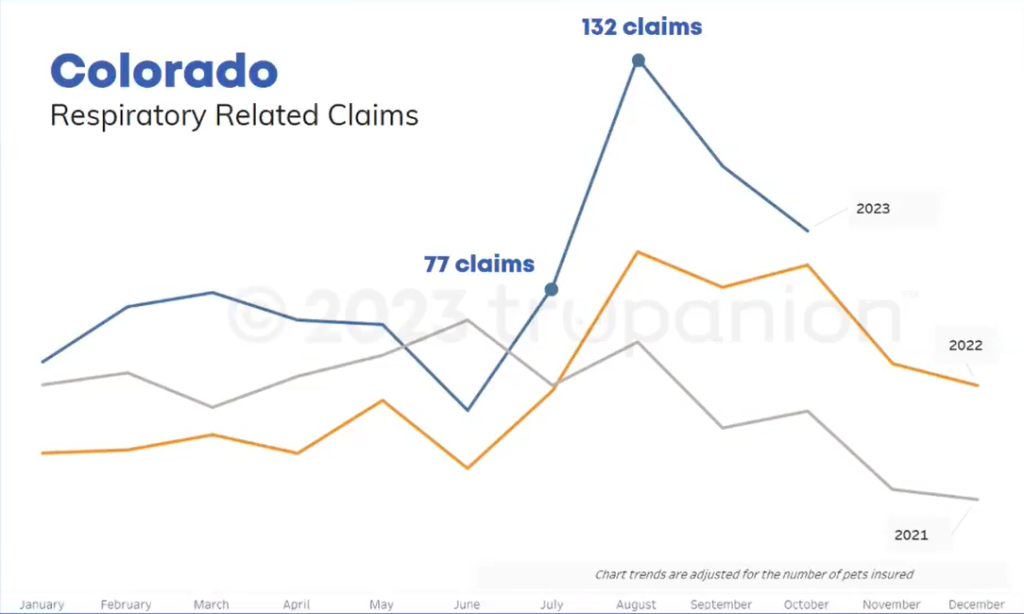Media outlets of all types have been abuzz lately with growing public concern over the wave of respiratory disease seen in our canine companions. Is this a new disease or an uptick in canine infectious respiratory disease complex, or CIRDC? As a retired veterinarian, but one who is involved in shelter and rescue medicine, I wanted to get some straight answers from some of the respected professionals in my field. To that end, I listened to a seminar hosted by Trupanion, an animal medical insurance company.
Four veterinarians participated in the Trupanion seminar.
- DR. STEVE WEINRAUCH BVMS, MRCVS is the Chief Veterinary/Product Officer of Trupanion. He was the host of the seminar.
- DR. SCOTT WEESE DACVIM is a veterinary internist, a Diplomate of the American College of Veterinary Internal Medicine, and a Fellow of the Canadian Academy of Health Sciences. He is a Professor at the Ontario Veterinary College, University of Guelph, Director of the University of Guelph Centre for Public Health and Zoonoses, Chief of Infection Control at the Ontario Veterinary College Health Sciences Centre, and is a member of numerous national and international committees dealing with infectious diseases and antimicrobial resistance.
- DR. MICHAEL LAPPIN PHD, DACVIM is a veterinary internist, a Diplomate of the American College of Veterinary Internal Medicine, holds a PhD in Parasitology, is Director of the Center for Companion Animal Studies at Colorado State University School of Veterinary Medicine and Chair of the World Small Animal Veterinary Association One Health Committee. He is also currently a Professor at the College of Veterinary Medicine and Biomedical Sciences at Colorado State University.
- DR. CARRIE JURNEY DACVIM is a veterinary neurologist and practice owner at Remedy Veterinary Specialists in San Francisco. She is a passionate advocate for mental health and wellbeing, and serves as the president of Not One More Vet 501(c)(3), the world’s largest wellness-focused charity for veterinary professionals.
Dr. Jurney was more of a special guest asking questions on behalf of the “rank and file” veterinary profession. Drs. Lappin and Weese answered most of the questions. I was unable to attend the seminar live but did watch it a couple of hours later. Approximately 8000 people registered for the seminar, of which half were veterinary professionals and half were pet parents. There was an opportunity to submit questions before the seminar.
What is CIRDC?
Dr. Weese writes a blog titled “Worms & Germs.” While I was previously unaware of this resource, I will be reading it regularly from now on! Dr. Weese provides a clear and succinct definition of CIRDC:
This syndrome is endemic in dogs and has a variety of known causes (e.g. canine parainfluenza virus, Bordetella bronchiseptica, canine respiratory coronavirus, canine pneumovirus, canine influenza virus, Streptococcus zooepidemicus… roughly in that order of occurrence, and maybe the enigmatic Mycoplasma as well). There are also presumably a range of other viruses involved that have been present for a long time but that we don’t diagnose.
Dr. Scott Weese, DACVIM
Just like everyone else, I have seen the circulating Facebook flurry of posts from pet owners, veterinarians, groomers, daycare owners, pet resort owners, dog show attendees, shelter workers, and just about everyone else whose day-to-day life revolves around dogs. There is even a new Facebook group dedicated to monitoring CIRDC, 2023 Canine Infectious Respiratory Disease Tracking. I learned about the Facebook group the day before I started writing this post.

There are countless posts describing horrific cases of pneumonia and respiratory disease in companion dogs that did not respond to traditional therapy. It would be easy to spend a relatively small amount of time reading through posts and conclude that there must be some new, highly virulent bug that is causing this apparent surge in cases.
However, that was NOT the message delivered by the two veterinary professionals who have a great deal of experience in veterinary medicine, infectious diseases, and microorganisms. While they have certainly not ruled out the possibility of an as-yet-unidentified pathogen, they seem to believe that we are seeing a flare-up of the usual respiratory disease culprits. Further quoting from Dr. Weece in his blog, Respiratory Disease in Dogs Sweeping Across the US: Outbreak of Disease or Media Attention? he says:
We see CIRDC all the time, anywhere there are dogs. There’s a background level of disease that usually flies under the radar, alongside periodic clusters of cases. I get lots of emails every week asking whether there’s more or more severe CIRDC activity at the moment, but I’ve been getting those reports for years, from across North America.
To me, that reflects the fact that CIRDC is always circulating, but we notice it more at certain times than others, either because of local clusters or, increasingly, local increases in awareness, often due to media coverage. Media and social media can drive outbreak concerns. They can be great to get the word out and help sort out issues, but often, they lead to false alarms.
Did the COVID pandemic contribute to this outbreak?
It isn’t just the veterinary profession and pet parents who are experiencing this phenomenon. Let’s look at an article by the BBC written in February of this year, The childhood diseases making a post-lockdown comeback. The subtitle of this article says it all… RSV, Strep A, the flu: a range of familiar bugs are worrying doctors and parents with strange new patterns. What’s behind the outbreaks? The article offers the following explanation:
When Covid-19 rampaged across the world, many countries introduced strict lockdowns to thwart transmission of the virus. Children were kept out of schools and nurseries for weeks or months on end. Now that they are mixing again, doctors have noticed periodic surges in other diseases, including RSV, flu, and illnesses caused by Group A streptococcus, a bacteria also known as strep A.
Chris Baraniuk Features correspondent
Not only did the article describe an increased number of cases of respiratory disease, but it also described what appeared to be increased virulence and even increased mortality. These are the exact concerns punctuating all of those frantic posts on Facebook.
Drs. Weese and Lappin believed that how owners handled and interacted with their dogs during COVID versus post-COVID has much to do with the spike in respiratory diseases that we are currently experiencing. Dogs were not exposed to pathogens which would keep their immune system “on duty.” Vaccines were skipped because clinics, groomers, and daycares were closed or offering limited services, money wasn’t earned, and neither man nor animal was interacting in public.
What are some indicators that this is not a new pathogen?
The host of the seminar I referenced is Trupanion, a companion animal medical insurance company. They shared some interesting data in the seminar, including graphs showing the fluctuations in client claims over the past few years. Interestingly enough, one of the poignant stories I read on the Facebook CIRDC page was from a woman who had two Doodles who became ill with CIRDC. Between her two dogs, Trupanion paid over $8000 in veterinary bills, after her deductible. The woman raved about the company and their customer service.
Here is one graph showing respiratory claims generated in Colorado.

Note that the claims for 2022 and 2023 are not as diverse as one would expect based on the media coverage of the past couple of months. While there is no question that there was an uptick in claims in late summer of this year, it does appear to mimic what pediatricians and parents reported after their kids began mingling again.
Dr. Weese addressed the question of whether or not this might be a new pathogen in one of his blogs. Rather than rehash it here, I refer you to his excellent article, New Weird Canine Respiratory Pathogen? What Do We Know? Suffice it to say that he believes the “potentially novel organism” being investigated by the New Hampshire Veterinary Diagnostic Lab will probably not turn out to be a causative agent of this respiratory storm. Both he and Dr. Lappin thought that a truly new pathogen would sweep the country in a much more overt and obvious fashion.
What can you do to protect your pets?
All of the panel members were unanimous in recommending that the best preventative measure a dog owner can take is to vaccinate their dog(s) for the usual respiratory pathogens. The most common offender is Bordatella or kennel cough. There are also vaccines available for canine parainfluenza (CPIV) and canine influenza (CIV).
Bordatella and Parainfluenza are included in the 5-way vaccine that most puppies receive during their initial vaccination and that adult dogs receive in yearly booster shots. Also included in the 5-way vaccine is protection against an adenovirus that can contribute to CIRDC.
It is postulated that vaccine-induced immunity to parainfluenza likely lasts less than 3 years. Here is an excellent article that discusses parainfluenza virus and its role in CIRDC. This article stresses the role that parainfluenza virus plays in
weakening a dog’s immune system and causing increased susceptability to other respiratory pathogens.
I read an AAHA article that discusses the three most common causes of CIRDC. It is a very informative article but it is written for veterinarians and is very clinical. I will give you the Cliff’s Notes version!

The canine influenza virus is a different pathogen than the parainfluenza virus. Two serotypes have been identified in North America. CIV is one of many pathogens that cause CIRDC: however, it has the potential to cause more severe disease than some of the other culprits.
CPIV is prevalent and often endemic in canine populations. Endemic means a disease that is always present in a population within a geographic area, typically year-round. CIV infections and clinical disease typically occur as multicentric and self-limiting outbreaks. Usually, vaccination against CIV is not recommended for the average family pet. Rather, dogs that are boarded and otherwise commingled at dog daycare, dog parks, dog shows and agility events, and dogs who travel should be vaccinated if an outbreak is occurring in their geographical area. Using a vaccine that includes both serotypes is preferable.
Should the “average family pet” receive a CIV vaccine during this surge in respiratory infections? My answer would be no, unless that pet has other conditions that might make it more susceptible to CIRDC. A “brachycephalic” dog, otherwise known as the squishy-faced breeds, would be a dog that might benefit from an influenza vaccine. Brachycephalic dogs are already predisposed to respiratory problems and would have a harder time recovering from CIRDC.

Old dogs and some immune-compromised dogs might be good candidates for CIV vaccination. However, one must weigh multiple variables. For instance, my old dog, Leah, has been diagnosed with Canine T-cell Lymphoma. Her age might qualify her as special needs, but her lymphoma diagnosis does the opposite. I have avoided vaccinating her and stimulating her immune system as her immune system is already “too hot.” Talk with your veterinarian if you think your dog has special needs that might warrant a CIV vaccination.
Besides making sure that your dog is current on all relevant vaccines, another way to protect your pet would be to analyze the “cost-benefit ratio.” Every time you expose your dog to other dogs, there is a risk. Remember all of the protocols that were in place for humans during COVID, and make similar decisions about where to take your dog. Decide if the benefit outweighs the potential cost.
The panel experts in the seminar discussed their clinic protocols for maintaining “biosecurity”. Ask your groomer or your veterinarian what disinfecting protocols they practice. Drs. Weese and Lappen believed most veterinary clinics practiced good biosecurity and would be a safe destination for routine care. They did emphasize the importance of educating clients about not bringing sick dogs into the clinic’s common areas. If your pet is sick, call ahead and make arrangements to enter through a side door or something similar.
DO NOT take a sick dog to a groomer, dog park, dog daycare, or other dog congregating facility. Just as we were expected to quarantine ourselves during COVID, you must have the same consideration for other dog owners and not expose their dogs to your sick pup. Dr. Weese wrote a great blog that provides sound advice to grooming facilities. Respiratory pathogens are spread by nose-to-nose contact, contact with secretions such as common dog bowls, and aerosolized droplets. COVID protocols called for 6 feet between people. Apply a similar restriction to your dog, perhaps increasing it to 10 feet or so.
When does a respiratory infection call for a trip to the vet?
If your dog is coughing but still eating and acting essentially normal, that is not a veterinary emergency. UPPER respiratory infections will often resolve on their own. Kennel cough caused by Bordatella is typically an UPPER respiratory infection. Dogs cough and honk like a goose, but they are generally not that sick. However, when an infection moves down into the lungs, that calls for veterinary intervention.
Dogs that are developing pneumonia will run a fever, be depressed, lose their appetite, and look like a miserably sick dog. Monitor your dog’s respiratory rate. A normal rate is 15-30 breaths per minute. A dog that is struggling to move air will pant when not hot, stressed, or exercising. They may have to open their mouth to breathe or use more abdominal effort to inhale. If you suspect that your dog is heading down that path, don’t waste time. Call your vet immediately.
What is an effective treatment?
Dr. Lappin recently participated in another panel that discussed CIRDC. Sixteen of the 17 panel members recommended doxycycline as the first line of defense against respiratory disease. The exception was if a dog had exposure to a horse, in which case the culprit might be a Strep bacteria. In that case, Amoxicillin would be the first drug of choice.
The panel members implored the pet parents who were participating in the seminar to not harass their veterinarians about getting antibiotics. Veterinarians may not prescribe antibiotics for a relatively mild infection where a dog is not that sick. Sometimes those infections are viral and antibiotics won’t work anyway. It is not because your vet doesn’t care, but rather because we know that microorganisms are increasingly resistant to our standard antibiotics. Please trust your vet to make the right decision about appropriate treatment.
The Facebook page that is exclusively dedicated to CIRDC has many posts discussing the use of chloramphenicol. Many pet parents were convinced that this antibiotic was so potentially toxic that it should never be used. It does have side effects and potentially serious consequences, both for dogs and their owners. However, I would again suggest that you trust your veterinarian to make intelligent decisions. You should definitely have input in to how your pet is treated, but if you don’t trust your vet to make good decisions, you need to find one that you do trust.
I hope after absorbing this information that you are at least a little less frantic about this recent surge in canine respiratory illness. Yes, it has been a rough few months (or year.) Yes, it can make your dog extremely sick. Yes, it can be scary and expensive. But you do have some control over exposure, prevention, and protection. Make good choices!











